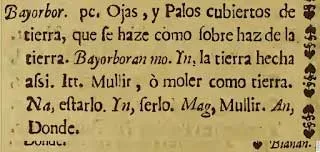Bayorbor in Mataasnakahoy and Bayudbod in Tuy: Lost Meaning of the Names
A quick examination of the names of the barrios around the province of Batangas and one quickly sees that there is a commonality to the names: most of them are named after plants, a geographical feature of the land, a prominent personality, or perhaps something related to religion like a saint.
From the so-called “historical data” written for many of the barrios in the early 1950s, one can get folkloric stories and other hypotheses about how some barrio names came to be. Just as many provide no clues at all, lost as the origins of the names had become in the mist of time.
[RELATED ARTICLE: Know the Most Frequently Used Names among the Barrios of Batangas.]
“Since this barrio came to existence, the popular name given to it was Bayorbor. It has no derivation whatsoever. It was the whim of the old settlers to call it so1.”
The document was written by public school teachers after consultation with the community between 1951 – when the instruction was given by the administration of President Elpidio Quirino – and 1953 – when the documents were collected by the national government.
It is, therefore, hardly surprising that, if one were to ask present residents what the name of their own barrio means, one is likely to draw a blank. The etymology of the barrio’s name was lost even roughly seventy years ago.
In fact, however, there is more to the name than having merely been the “whim of the early settlers,” as the historical document conjectured. The 1754 edition of the antique Spanish language book “Vocabulario de la Lengua Tagala2 (Vocabulary of the Tagalog Language) provides the meanings of the by-now archaic or no longer used word “bayorbor.”
Bayorbor. pc, Ojas [hojas], y Palos cubiertos de tierra, que se haze como sobre haz [sobrehaz] de la tierra. Bayorboran mo. In, la tierra hecha assi [asi]. Itt. Mullir, o moler como tierra. Na, estarlo. In, serlo. Mag, Mullir. An, Donde.
“Hojas y palos cubiertos de la tierra que se haze como sobrehaz de la tierra” roughly translates as “leaves and sticks covered with earth which are an overlay or covering of the ground.”
“La tierra hecha asi” roughly refers to “land made like this,” i.e. with leaves, sticks and earth. “Mullir, o moler como tierra” is roughly translated into “fluff or grind like earth.”
Elsewhere in “Vocabulario de la Lengua Tagala,” bayorbor was also described as “buhaghag,” a Tagalog word still presently used and means “loose.”
As previously mentioned, in some cases, barrio names had been given by early settlers based on land features. From the context of the definitions provided by “Vocabulario de la Lengua Tagala,” it is entirely possible that the name Bayorbor given by the early settlers of the barrio in Mataasnakahoy was descriptive of the properties of the land, i.e. covered by leaves, sticks and loose earth.
This idea is given credence by an unpublished history3 of Mataasnakahoy written by one Ceferino Capuchino, a local researcher. In his narrative, Capuchino wrote that the entire town was, until the 19th century, a “pulong gubat” (a forest or jungle) with lush vegetation.
The early settlers would have had to fell trees to clear the land for cultivation, and that land, needless to say, would have indeed been “bayorbor,” i.e. loose and filled with sticks and leaves. Alternatively, the word could have been used to describe what was needed to be done to prepare the land for agriculture, i.e. grind or loosen the soil for planting.
[RELATED ARTICLE: History and Cultural Life of the Barrio of Bayorbor.]
Interestingly, there is a barrio in Tuy by the name of Bayudbod (or Bayudbud). Regrettably, there was no “historical data” written for this barrio. However, because the preference in western Batangas and the northern Tagalog provinces has been for the sound “d” at the end of syllables, as opposed to the “r” that used to be preferred in eastern Batangas4, then we can all assume “bayorbor” to be exactly the same word as “bayudbod.”
Thus, the origin of Bayudbod’s name was most likely the same geographic feature as that of Bayorbor in Mataasnakahoy.
2 “Vocabulario de la Lengua Tagala,” by P. Ivan de Noceda and P. Pedro de San Lucar, published 1754 in Manila.
3 “Sa Langit-langitan ng Bayan Ko,” written by Ceferino Capuchino in 1998. A copy of the narrative was obtained by Batangas History through the kindness of Renz Marion Katigbak.
4 Even in eastern Batangas, the preference for the sound “r” at the end of syllables has disappeared, except, perhaps, among the elderly and in remote rural communities.


